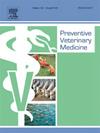Salmonella and antimicrobial-resistant bacteria recovered from livestock feed components include Escherichia coli ST167 expressing NDM-5 carbapenemase
IF 2.4
2区 农林科学
Q1 VETERINARY SCIENCES
引用次数: 0
Abstract
Antimicrobial-resistant bacteria, including both pathogens and commensal organisms, can be introduced into livestock populations by a variety of mechanisms including contaminated water, animal and human movement, and animal feed. We hypothesized that animal feed is an important mechanism for introduction of both Salmonella and commensal reservoir bacteria harboring mobile antimicrobial-resistance genes into livestock populations. The identification of high-risk feed components may allow targeted interventions that will reduce carriage of these organisms in food animals and ultimately improve food safety. We collected 666 livestock feed component samples from 16 individual local mills (n = 263) and from 2 corporations with multiple feed mills located across the US (n = 403). Salmonella enterica were recovered from 7.2 % of samples (n = 48) and were more likely to be found (P < 0.02) in blended feeds, animal protein components, and oilseed meals. We also recovered two carbapenem-resistant Enterobacterales isolates (0.3 %), both E. coli sequence type 167 O101:H9 carrying an IncF plasmid mediated blaNDM-5, from two dried distiller’s grain samples sourced from two states in the upper Midwest. Antimicrobial-resistant commensal bacteria were found in all feed component types, although the overall prevalence of each resistance phenotype was below seven percent except for AmpC β-lactamase producing strains (19.5 %). The identification of feed components with higher risk of contamination suggests that targeted interventions could potentially reduce feed contamination. Contamination reduction efforts focusing on feed components with heating and cooling steps may reduce the proliferation of pathogens and resistant bacterial strains in finished feed fed to livestock.
从牲畜饲料成分中回收的沙门氏菌和抗微生物细菌包括表达NDM-5碳青霉烯酶的大肠杆菌ST167
抗微生物药物耐药性细菌,包括病原体和共生生物,可通过各种机制(包括受污染的水、动物和人类的运动以及动物饲料)传入牲畜种群。我们假设动物饲料是将沙门氏菌和携带移动抗微生物抗性基因的共生宿主细菌引入牲畜种群的重要机制。对高风险饲料成分的识别可能允许进行有针对性的干预,从而减少这些生物在食用动物中的携带,并最终提高食品安全。我们从16个单独的当地饲料厂(n = 263)和2家在美国拥有多个饲料厂的公司(n = 403)收集了666个牲畜饲料成分样本。肠道沙门氏菌在7.2 %的样品中被检出(n = 48),在混合饲料、动物蛋白成分和油籽粕中更容易被发现(P <; 0.02)。我们还从中西部北部两个州的两份干蒸馏酒样品中回收了两株耐碳青霉烯类肠杆菌(0.3 %),均为大肠杆菌序列型167 O101:H9,携带IncF质粒介导的blaNDM-5。在所有饲料成分类型中均发现了耐药共生菌,尽管除了AmpC β-内酰胺酶产生菌株(19.5% %)外,每种耐药表型的总体患病率均低于7%。对污染风险较高的饲料成分的识别表明,有针对性的干预措施可能会减少饲料污染。通过加热和冷却步骤对饲料成分进行污染减少工作,可以减少饲喂牲畜的成品饲料中病原体和耐药菌株的增殖。
本文章由计算机程序翻译,如有差异,请以英文原文为准。
求助全文
约1分钟内获得全文
求助全文
来源期刊

Preventive veterinary medicine
农林科学-兽医学
CiteScore
5.60
自引率
7.70%
发文量
184
审稿时长
3 months
期刊介绍:
Preventive Veterinary Medicine is one of the leading international resources for scientific reports on animal health programs and preventive veterinary medicine. The journal follows the guidelines for standardizing and strengthening the reporting of biomedical research which are available from the CONSORT, MOOSE, PRISMA, REFLECT, STARD, and STROBE statements. The journal focuses on:
Epidemiology of health events relevant to domestic and wild animals;
Economic impacts of epidemic and endemic animal and zoonotic diseases;
Latest methods and approaches in veterinary epidemiology;
Disease and infection control or eradication measures;
The "One Health" concept and the relationships between veterinary medicine, human health, animal-production systems, and the environment;
Development of new techniques in surveillance systems and diagnosis;
Evaluation and control of diseases in animal populations.
 求助内容:
求助内容: 应助结果提醒方式:
应助结果提醒方式:


